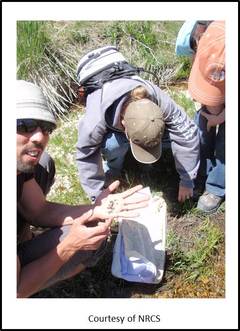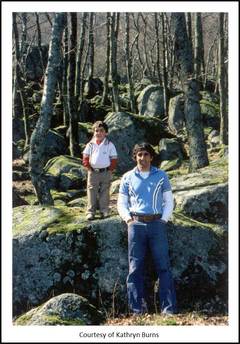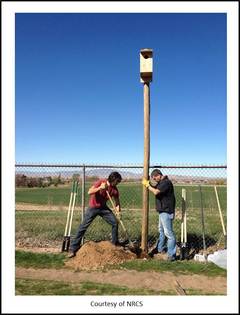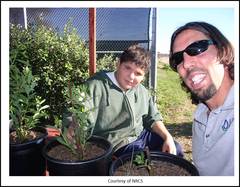
Name: Casey Burns
- Education: M.S. Conservation Biology, University of Missouri, St. Louis; B.A. Biology and Environmental Studies, Drury University
- Target Audience: Middle School
Wildlife biologists like Casey Burns are focused on conserving wildlife and other natural resources. Read on to learn the lay of the land when it comes to conservation.
What is your job?
Biology is the study of life, and a biologist can have a wide array of different types of jobs. People who study cells, genes, diseases, viruses, plants, animals, and ecology are all biologists. I am a biologist for the United States Department of Agriculture (USDA) Natural Resources Conservation Services (NRCS) and I focus on wildlife and conservation biology. When working on a project at NRCS we try to promote conservation of all natural resources. Often the things that I do for animals are also good for soil, water, air, plants and even people. The ecosystem is linked and it is hard to focus on just one thing without considering its effect on other things. For example, projects to help conserve water for use by people can also help make sure there is enough water for fish to live in and animals to drink.
Department of Agriculture (USDA) Natural Resources Conservation Services (NRCS) and I focus on wildlife and conservation biology. When working on a project at NRCS we try to promote conservation of all natural resources. Often the things that I do for animals are also good for soil, water, air, plants and even people. The ecosystem is linked and it is hard to focus on just one thing without considering its effect on other things. For example, projects to help conserve water for use by people can also help make sure there is enough water for fish to live in and animals to drink.
My job title is State Biologist, so I get to work all over Utah. Utah is a beautiful state with many different types of plants, animals, and habitats, many of which need conservation help. Since NRCS is in the USDA, most of what I do involves working with farmers and ranchers. It is interesting and challenging to try to improve habitat for wildlife and still make sure that farmers and ranchers can make a living and supply people with food. Many times, when we help people conserve natural resources it makes their farm or ranch more sustainable. Sustainable means to be able to continue to use natural resources without depleting them. Sustainable use of natural resources is important for both people and wildlife.
An important part of my job is to take science and turn it into conservation. There are many scientists doing research, and many people implementing conservation projects. The conservation project I work on will not be successful if it is not based on the best science, and the best science will not be useful if we cannot turn it into conservation.
Why did you choose this career? Was there a particular moment you knew you wanted to become a biologist?
I always wanted to work outside with plants and animals. When I was very young, my favorite thing to do was explore tide-pools for creatures. It was so exciting because each time you looked into a tide-pool you never knew what surprise you would find. I always had my collection bag with me when I was a kid. It was a cotton bag my grandma made for me that I put sticks, rocks, leaves, and whatever else that I found. As a conservationist I now understand that sometimes it is important to leave things where you find them, since animals could be using them for food or cover.  By the time I was in high school I knew I want to be a biologist and do conservation work. I didn’t yet know about all the available jobs in conservation, but I still knew I wanted to work outside with plants and animals. I took classes and worked summer jobs related to the field in college and it really helped me figure out which biology job was right for me. I was lucky in a way, since I always had a good idea of what I wanted to do. It helped me stay focused and work towards something. The sooner you can figure out what you want to do, the better.
By the time I was in high school I knew I want to be a biologist and do conservation work. I didn’t yet know about all the available jobs in conservation, but I still knew I wanted to work outside with plants and animals. I took classes and worked summer jobs related to the field in college and it really helped me figure out which biology job was right for me. I was lucky in a way, since I always had a good idea of what I wanted to do. It helped me stay focused and work towards something. The sooner you can figure out what you want to do, the better.
Explain what an average day at work is like for you.
Outside of my daily planning and prioritization to ensure we’re helping wildlife in the most efficient and effective way possible, my days are very diverse. One day I may be helping farmers and gardeners attract pollinators to their crops. Many plants, such as cherries, apples, peaches, watermelons, and tomatoes, need pollinators to help them make fruit. Bees are the best pollinators. In addition to honeybees, there are thousands of different native bees in the US and the best way to get them to help pollinate is to plant many different flowering plants near the crops. I help the farmers figure out which flowers to plant and where to plant them. We also think about providing places for the bees to nest and how to protect them from insecticide.
Another day I may figure out how to let cows graze an area, but also make sure there is enough food and cover for wildlife. If you can plan it right, you may be able to use the cows to help control weeds and keep vegetation healthy. If you don’t plan it right, the cows may eat everything and leave no food or cover for wildlife or for cows next time they want to graze that area. Since much of Utah’s land has cows grazing on it, it is very important to work with the rancher to develop a sustainable plan for grazing.
I also spend a lot of time working with rivers, the wildlife that depend on them, and the people that live next to them. Rivers and the strips of riparian habitat next to them usually have a greater diversity of animals than any other habitat. There are usually endangered species, like fish or birds, which live in the willows and cottonwoods next to the rivers. People also like to live next to rivers, since there is plenty of fresh water, good soil for growing crops, and nice scenery. All rivers will flood occasionally, and while that is usually good for the animals and plants, it is not always good for people or their houses and nearby roads. I try to help people protect their houses, roads, and farms in a way that still leaves enough space for the river, the riparian habitat next to the river and all the animals that live there. This is a tricky job and we have to work with many different professionals to ensure we get it right.
 What do you like best about your job?
What do you like best about your job?
I have a great job, so it is hard to choose one thing I like best. The most satisfying thing is to see a habitat project that I planned successfully completed and that animals are using it for a habitat. When you see animals in an area where they could not live before, it is very satisfying. Even seeing a tree you planted grow or seed you scattered sprout is very rewarding.
I also really like working with people. I learned that there is only so much I can do by myself. It is very important to teach other people how to manage the land to benefit wildlife. It is very rewarding to be able to work with people and teach them how to manage land better for plants and animals.
One of the best things about my job is the diversity. Utah is a big state with many different habitats, plants, and animals. I could be working with desert tortoise in the Mojave Desert one day, then working on wetlands in the mountains the next day, then be working with an apple farmer to get more bees to help pollinate the apple flowers, then be in an important meeting with other biologists to figure out which animals are most important to protect in Utah. Really, the best thing is to know what I do is helping make positive changes for wildlife and people.
When you were a kid, did you like science, engineering and/or math?
I think all kids like animals and that interest never left me. However, I always liked geography the best growing up. Geography is the study of places, people, animals, and processes. I had a map collection (and still do) that I looked at and would dream of what it was like in far off places, as well as nearby parks, mountains, and canyons. As I got older, I got to explore a lot of the far off and local places I dreamed of as a kid for fun and for work.
What was the biggest challenge you faced in your journey to becoming a biologist?
biologist?
I was always a decent student, but never was the smartest kid in the class. I actually was only an average biology student until about the middle of college. My biggest challenge came in my first two years in college when I got a few bad grades. Once I started taking the classes that I was really interested in like stream ecology, environmental geoscience, and field botany, I started to excel as a student. The only time I ever got straight A’s was when I was a senior in college. Once I started to do well in school and knew I was very interested in conservation and I knew I wanted to go to graduate school for a Master’s degree.
Was there a person or group who inspired or convinced you to get involved in your field?
There were a few different people that really helped me. I could not have done it without my parents, who both have always been very supportive and inspirational to me. My dad taught me to love being outside and my mom inspired my interest in science and nature. We lived many places and traveled a lot when I was growing up, which I think helped me see the big picture and prepared me to be able to think about things on a larger scale.
I had one professor in college who was very helpful in guiding me into graduate school and the right career path. I had another professor in college who was great at getting me hands on experience in field research projects and helped me to understand what being a biologist would really be like. I went to a smaller college, which was valuable to me since I had extensive interaction and support from my professors.
It may sound weird, but I think playing sports and being in clubs was also very important to me in high school. Being involved and committed to different groups kept me more focused on doing well in school.

Do you have any suggestions for how kids in middle school can get practical experience in your field? Are there any high school courses that you think would be important to take?
I think the science fair is a great tool for kids to start to get practical experience in science. You could ask a local biologist to help you with a project. I know I would be glad to help a kid who was interested in doing a project studying biology or conservation. Try to find a project that has a practical application in the real world. As far are courses go, when you reach high school be sure to take biology, chemistry, and physics. Math classes, such as statistics and calculus are important too. Speaking a foreign language like Spanish, French, Arabic, or Chinese, is always an advantage. Try to get good grades in all your classes and start thinking about applying for college.
Where do you see your industry going in the future? Are there any exciting changes or innovations that kids pursuing your field can look forward too?
 It seems like conservation efforts are getting larger in scale and more interdisciplinary. People, organizations, and agencies seem to be working together across larger areas and achieving bigger goals than they could accomplish alone. It seems more common to have lots of different people and groups working together to help a species before it becomes endangered. It is certainly easier to accomplish larger conservation goals when we all work together.
It seems like conservation efforts are getting larger in scale and more interdisciplinary. People, organizations, and agencies seem to be working together across larger areas and achieving bigger goals than they could accomplish alone. It seems more common to have lots of different people and groups working together to help a species before it becomes endangered. It is certainly easier to accomplish larger conservation goals when we all work together.
Do you have closing remarks to encourage students to pursue your field or similar STEM subjects?
People skills and communication are very important, and often underrated, components of what it takes to be a good biologist. Good teaching and presentation skills are very important.
Find a mentor, or multiple mentors. Many of the biologists I know would be glad to help mentor a young biologist and give them advice on how best to get experience and a job.
The Buzz on Pollinators:
- About 35 percent of the world’s food crops depend on animal pollinators, like bees, to reproduce. More than 3,500 species of bees help increase crop yields.
- Pollinators are declining. Gardeners and farmers can help pollinators by reducing or eliminating pesticide and insecticide use in their landscape or fields, or incorporate plants that attract insects used for pest control.
- Don’t forget the bees. Farmers who create or enhance pollinator habitats can receive special consideration for financial assistance under the Farm Bill.
(adapted from NRCS.USDA.gov)
Land & Wildlife Lingo:
Conservation - the careful utilization of a natural resource in order to prevent depletion.
Ecosystem – a system formed by the interaction of a community of organisms with their environment.
Endangered Species - a species at risk of extinction
Environmental Geoscience – the cross-pollination of geology and geography for those interested in geological and geographical approaches to environmental issues
Field Botany – the study of study plants, as well as fungi and algae
Geographic Information Systems (GIS) – a system that integrates hardware, software, and data for capturing, managing, analyzing, and displaying all forms of geographically referenced information.
Geomorphology - the study of the characteristics, origin, and development of landforms.
Habitat - the natural environment of an organism;
Insecticide - a substance used for killing insects.
Natural Resources - the natural wealth of a country, consisting of land, soil, forests, mineral deposits, water, wildlife, etc.
Pollinators - can be bees, butterflies, moths, beetles, birds, or many other animals that pollinate flowering plants
Riparian Habitat –the type of wildlife habitat found along the banks of a river, stream, lake or other body of water
Stream Ecology - the branch of biology dealing with the relations and interactions between stream organisms and their environment, including other organisms
Tide-pool - small pools of seawater left over when the tide is low
(adapted from dictionary.com)


















